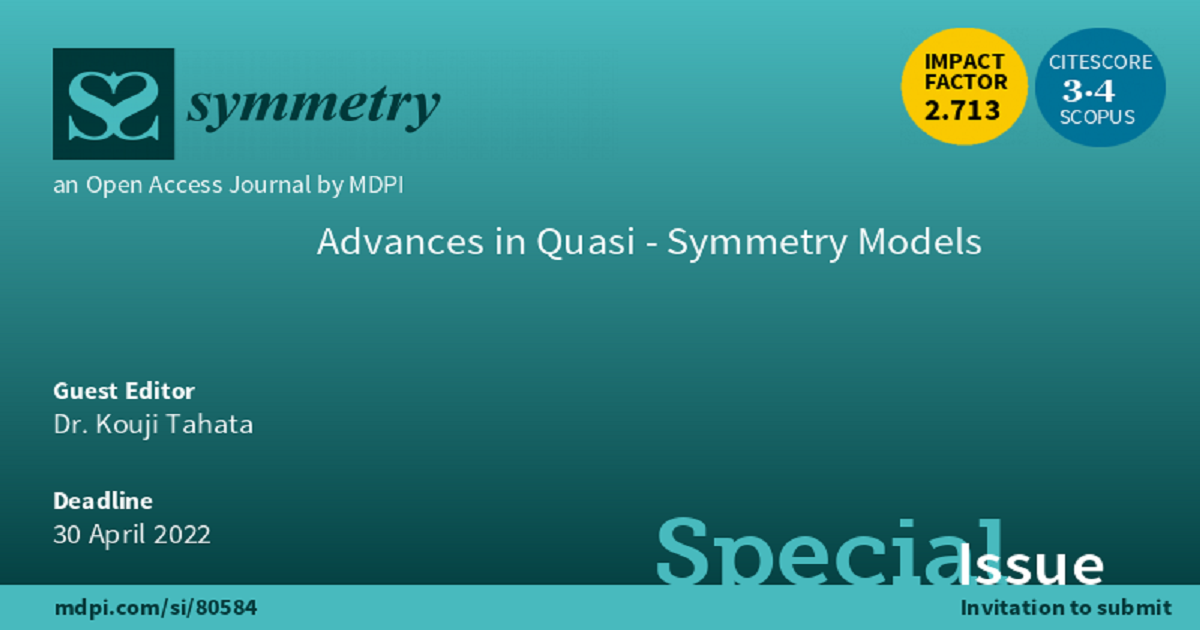Advances in Quasi-Symmetry Models
A special issue of Symmetry (ISSN 2073-8994). This special issue belongs to the section "Mathematics".
Deadline for manuscript submissions: closed (30 April 2022) | Viewed by 17793

Special Issue Editor
Special Issue Information
Dear Colleagues,
This Special Issue focuses on contingency table analysis in the statistical analysis of categorical data. The contingency table plays an important role in various fields. The issues of symmetry rather than independence (null association) are specifically considered for the analysis of square contingency tables because many observations tend to concentrate on or near the main diagonal. Caussinus proposed quasi-symmetry and used it as a bridge between symmetry and marginal homogeneity in square tables. The result had an impact on some methodological developments in the statistical analysis of categorical data. A special issue of Annales de la Faculté des Sciences de Toulouse, Mathématiques was published in 2002 which contained the papers written by internationally distinguished authors on topics related to quasi-symmetry. Almost twenty years have passed since then, and many more papers which treat quasi-symmetry from a variety of perspectives have been published. Therefore, we are soliciting contributions (research and review articles) covering a broad range of topics on symmetry and quasi-symmetry for the present Special Issue on “Advances in Quasi-Symmetry Models”.
Dr. Kouji Tahata
Guest Editor
Manuscript Submission Information
Manuscripts should be submitted online at www.mdpi.com by registering and logging in to this website. Once you are registered, click here to go to the submission form. Manuscripts can be submitted until the deadline. All submissions that pass pre-check are peer-reviewed. Accepted papers will be published continuously in the journal (as soon as accepted) and will be listed together on the special issue website. Research articles, review articles as well as short communications are invited. For planned papers, a title and short abstract (about 100 words) can be sent to the Editorial Office for announcement on this website.
Submitted manuscripts should not have been published previously, nor be under consideration for publication elsewhere (except conference proceedings papers). All manuscripts are thoroughly refereed through a single-blind peer-review process. A guide for authors and other relevant information for submission of manuscripts is available on the Instructions for Authors page. Symmetry is an international peer-reviewed open access monthly journal published by MDPI.
Please visit the Instructions for Authors page before submitting a manuscript. The Article Processing Charge (APC) for publication in this open access journal is 2400 CHF (Swiss Francs). Submitted papers should be well formatted and use good English. Authors may use MDPI's English editing service prior to publication or during author revisions.
Keywords
- Contingency table (multi-way contingency table)
- Correspondence analysis (association model)
- Cumulative probability (marginal distribution)
- Decomposition (equivalence conditions for symmetry)
- Information theory (KL divergence, f-divergence)
- Log-linear model (multiplicative form)
- Measure (index of degree of departure from symmetry)
- Test (exact test, orthogonality)
Benefits of Publishing in a Special Issue
- Ease of navigation: Grouping papers by topic helps scholars navigate broad scope journals more efficiently.
- Greater discoverability: Special Issues support the reach and impact of scientific research. Articles in Special Issues are more discoverable and cited more frequently.
- Expansion of research network: Special Issues facilitate connections among authors, fostering scientific collaborations.
- External promotion: Articles in Special Issues are often promoted through the journal's social media, increasing their visibility.
- Reprint: MDPI Books provides the opportunity to republish successful Special Issues in book format, both online and in print.
Further information on MDPI's Special Issue policies can be found here.





